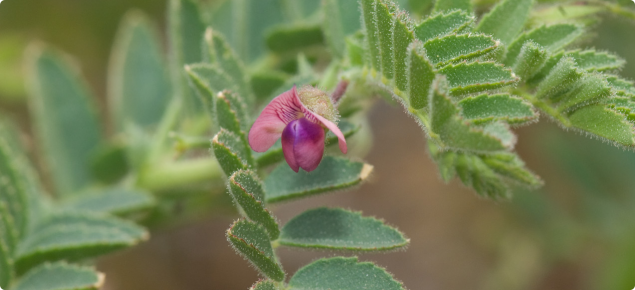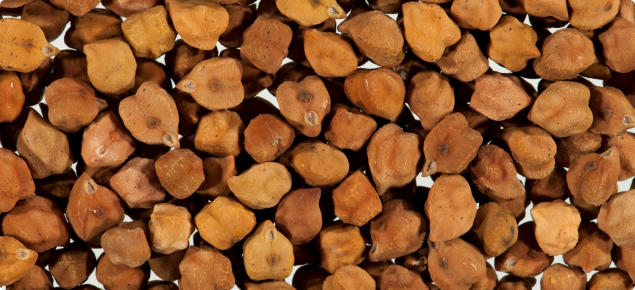Key features
- Desi chickpea variety that combines early flowering, competitive yield and ascochyta blight resistance.
- Ascochyta blight resistance is rates as resistant (R).
- It is the earliest flowering and earliest maturing of all current varieties making it particularly well suited to short season environments.
- Bushy growth habit and profuse branching helps to utilise good growing conditions.
- Seed size is similar to Genesis 836, 16 grams per 100 seeds.
- A uniform seed size and light brown seed coat colour make it attractive for marketing.
Name
Ambar is a Hindu/Urdu (the most widely spoken languages in the Indian subcontinent) word referring to the gem, amber. This follows the Western Australian convention of naming chickpea varieties in the language of the target market and referring to gems or precious metals found in Australia.
It has been tested as WACPE2136 and 99262-WA10.
Breeding
This variety has been developed by Dr Tanveer Khan — former Department of Agriculture and Food, Western Australia (DAFWA) plant breeder, Winthrop Professor Kadambot Siddique (University of Western Australia) and the DAFWA pulse breeding team. The cross (ICCV92501/ICC13729//WACPE2021/ICCV96808) was made in 1999 in Tamworth and then transferred as F4 generation to WA. The segregating population was grown at Merredin in 2003 and subjected to ascochyta blight epidemic. A single plant showing ascochyta blight resistance and desirable agronomic traits was harvested individually and progeny grown in 2004, again at Merredin, along with other single plant selections. This line was then observed as genetically fixed and tested at multi-locations breeding trials until 2011.
Agronomic characteristics
The agronomy of growing Ambar is similar to all current Australian chickpea varieties.
Ambar has the following agronomic characteristics:
- Ambar is the earliest flowering and earliest maturing variety of the current varieties in southern Australia.
- Similar plant height to PBA Slasher.
- Like PBA Slasher, Ambar is a short, bushy semi-prostrate plant type.
- Lodging has not been seen in any trials in WA including trails where Ambar has yielded more than four tonnes per hectare (t/ha).
- Ambar has robust resistance to ascochyta blight as found over several years of testing in WA and in variable environment is India and New South Wales.
| Variety | Seed weight (g/100) | Seed colour | Flowering time | Maturity time | Plant height | Lodging |
|---|---|---|---|---|---|---|
| Ambar | 16 | light brown | early | early | short-med | MR |
| Neelam | 17 | brown | mid | mid | med-tall | MR |
| PBA Slasher | 21 | brown | mid | mid | medium | MS |
| Genesis 836 | 17 | light brown | mid | mid-late | tall | MR |
| Variety | Ascochyta blight resistance | Ascochyta rating | Botrytis grey mould |
|---|---|---|---|
| Ambar | R | 3.8 | S |
| Neelam | R | 3.9 | S |
| PBA Slasher | R | 4.1 | S |
| Genesis 836 | MS | 4.8 | S |
Area of adaptation
Ambar is well adapted to most of southern Australia with particular preference for the northern wheatbelt of WA. Its early flowering habit makes it well suited to shorter growing season (low rainfall) environments.
Yield
Ambar yields are similar to PBA Slasher. However, in a number of high yielding situations, particularly in the northern areas of WA, it has given very good yields. Its bushy habit and profuse branching enables it to take advantage of good growing conditions.
For latest trial results see the National Variety Trials website.
| Variety | South-east South Australia | Mid-north South Australia | Upper Eyre Peninsula | Yorke Peninsula | Victoria Mallee | Victoria Wimmera | WA AgZone 1 | WA AgZone 2 | WA AgZone 4 |
|---|---|---|---|---|---|---|---|---|---|
| Ambar | 2.01 | 2.07 | 0.91 | 2.07 | 1.36 | 1.33 | 1.40 | 1.16 | 1.06 |
| Neelam | 2.04 | 2.11 | 0.94 | 2.07 | 1.44 | 1.41 | 1.45 | 1.24 | 1.11 |
| Genesis 836 | — | 1.92 | — | 1.88 | 1.30 | 1.27 | 1.36 | 1.14 | 1.05 |
| PBA Slasher | 2.03 | 2.13 | 0.93 | 2.08 | 1.43 | 1.40 | 1.41 | 1.19 | 1.08 |
Management package
Paddock selection
Select paddocks which have:
- Well drained soils with a pH above 5.5 (calcium chloride, CaCl2), heavy deep clays, heavy loam, sandy loam and loamy sands. Avoid soils with a pH below 5.5 (CaCl2), saline soils, high boron soils and acid (Wodjil) soils. Chickpea has poor tolerance of low pH, particularly where aluminium toxicity can be a problem.
- A soil structure and slope which allows good drainage — avoid shallow soils.
- Little or no risk of sulfonylurea carryover.
- A low broad-leaf weed burden.
- Few rocks and roots and can be left relatively flat and even after sowing for harvest.
To minimise the risk of disease, do not grow chickpea more often than one year in four in the same paddock and at least 500 metres from previous seasons chickpea stubble.
Sowing
- Target the sowing date used for desi chickpea in your region. Gains in yield and grain quality can be made from timely sowing.
- Sowing depth: aim for a sowing depth of 5cm, chickpeas will tolerate sowing to 8cm with moist soil conditions.
- Sowing rate: 40-45 plants per square metre (plants/m2) is the optimum plant density which corresponds to a sowing rate of between 90-100 kilograms per hectare (kg/ha) subject to seed size and germination test.
- Row spacing: trials and commercial experience indicate that there is little or no yield penalty with wide row spacing up to 60cm.
Fertiliser
Chickpea is effective at extracting phosphorus (P) and shows no yield response to additional P at soil levels above 20 milligrams per kilograms (mg/kg) (Colwell test). If levels in the soil are between 10mg/kg and 20mg/kg, add at least 8kg P/ha. As a guide, approximately 3.2kg of P is exported in one tonne of chickpea grain.
Inoculum
Inoculate with Group N chickpea rhizobia inoculum at sowing. This applies regardless of the cropping history of the paddock, and inoculation is recommended in all circumstances.
All chickpea seed should receive a fungicide seed dressing (P-Pickle-T) to reduce ascochyta blight, however fungicide seed dressings are toxic to rhizobia. The pickle must be applied first (maybe months in advance) and allowed to dry before inoculum is applied. Alternatively, use a granular Group N inoculum product.
Herbicide sensitivity
Herbicide tolerance trials in WA during 2010 and 2011 (Mullewa red sandy loam, Mingenew red clay loam soils) show that herbicides commonly used in chickpea production can be used on Ambar with the same degree of safety. Severe seasonal effects on herbicide activity can occur and work in ongoing to validate findings under differing seasonal conditions.
Refer to the National Variety Trials website for current trial results.
Disease management
To minimise yield losses to ascochyta blight, botrytis grey mould and phytophthora, follow local best management guidelines for your region. Use a seed dressing (containing thiram or thiabendazole plus thiram) for the control of ascochyta blight, botrytis grey mould and common root rots.
Aschochyta blight disease management with Ambar is the same as with the other ascochyta resistant (R) varieties PBA Slasher or Genesis 090:
- Fungicide sprays (a.i.chlorothalonil) are unlikely to be required before podding, but monitor crops for signs of disease.
- In WA, an early fungicide application is recommended 6-8 weeks after sowing to delay the development of ascochyta blight.
- In all regions, monitor crops and use a foliar fungicide at early podding prior to rain to ensure pods are protected, and high quality, disease free grain is produced.
- Pods of Ambar can be affected by ascochyta blight, and this can result in poor quality, discoloured grain or seed abortion and yield loss in severe disease situations.
All current varieties are susceptible to botrytis grey mould. There is a risk of infection in Ambar if a dense, bulky canopy develops during a favourable growing season.
- Apply a fungicide prior to canopy closure in botrytis grey mould prone areas and continue monitoring. Apply further fungicide applications if the disease is present.
Insect control
Chickpea is highly susceptible to native budworm. Crops need to be monitored from flowering through to pod fill. Small grubs less than 1cm are damaging. Economic thresholds for control can be as low as one grub in 20 sweeps.
Harvesting
The crop is ready to harvest when the stems and the majority of pods are light brown and the seed is hard and rattles within the pod. Seed moisture needs to be less than 14%. Pods will be shed if harvest is delayed.
Suggested harvester setting are:
- Reel speed 1.0 x ground speed.
- Table auger 10-20mm.
- Drum or rotor speed 300-600rpm.
- Concave clearance 10-25mm (start at 10mm clearance).
- Fan speed 75-100% (state at 100%).
- Top sieve: 16-25mm (start at 25mm).
- Bottom sieve: 8-16mm (start at 16mm).
Marketing
Ambar grain is a desi type chickpea suitable for the whole and splitting human food markets. Seed size of Ambar similar to that of Genesis 836 but smaller than PBA Slasher. However, its seed coat colour is lighter than PBA Slasher. The seed size is very uniform and this coupled with seed colour make it attractive for marketing. Other quality attributes also compare well with current varieties.
Seed availability
Ambar is currently available and is being commercialised through Heritage Seeds.


